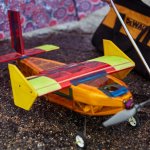115 Years, 115 Impactful Moments
Click to play USC Viterbi's 115th anniversary trivia game
 In 1905, USC offered its very first engineering courses out of the physics and mathematics departments.
In 1905, USC offered its very first engineering courses out of the physics and mathematics departments.
One hundred and fifteen years later, the USC Viterbi School of Engineering has a name and a host of accomplishments over the ensuing 11.5 decades.
This past May, Dean Yannis Yortsos, working with USC Viterbi vice deans, chairs, and select senior faculty, sought to identify 115 amazing USC Viterbi accomplishments by faculty, students and alumni over that span of time. This list would span all eight departments, the famed USC Information Sciences Institute and various programs of the school.
This list, like many of its kind, suffers from a clear recency bias. It is by no means the definitive list of all the USC Viterbi School’s noteworthy accomplishments! However, despite these limitations, perhaps it will serve as a helpful primer on what George Bekey, USC Viterbi professor emeritus, once called the school’s “remarkable trajectory.”
Test your knowledge of these USC Viterbi “wins” in a “Who Wants To be A Millionaire”-style interactive game above.
Or, for those who prefer to dive right in…the full list of 115 accomplishments for 115 years awaits.
Aerospace and Mechanical Engineering

Twelve USC Viterbi alumni have journeyed beyond Earth’s atmosphere as NASA astronauts.
These include: Charlie Bolden, former NASA administrator, who flew on four space shuttle missions; and Nancy Currie-Gregg, who flew in four space shuttle missions, accruing 1,000 hours in space. In addition, Professor Garett Reisman spent 95 days aboard the International Space Station after which he returned to Earth aboard the Space Shuttle Discovery in 2008. Professor Paul Ronney, now AME department chair, was selected as an alternate payload specialist astronaut. His experiments flew on two Columbia Space Shuttle missions in 1997 (the mission he was backup for) and one in 2003.

USC Engineering secured its first major research contract in 1944 in the amount of $10,000 from Lockheed Aircraft for studies of spot-welding aluminum alloy.

In 1974, Fred Browand published the classic paper that builds on work by Richard Kaplan and Ron Blackwelder on how to reduce air drag on vehicles, research that continues to influence vehicle design to this day.
Cited 1400 times, it was the first to show experimentally that two or more vortices in fluid flows have tendency to merge to form larger vortices. This concept continues to be utilized today to control the growth of the shear layers, reduce noise from jets and control the mixing within shear layers.

Terence Langdon, who served as a professor in three USC departments, elongated metals by a record 7000% in the 1980s.
His research focused on creep, superplasticity and UFG materials and he published over 1,000 peer-reviewed papers.

In 1964 Janos (John) Laufer, left the Jet Propulsion Laboratory to found and chair the USC Viterbi Department of Aerospace Engineering.
Laufer was renowned for his work in fluid mechanics and died in 1983.

USC Viterbi's Aircraft Investigation Lab is among the best in the world.
For over 60 years, USC professors have taught pilots, aircraft investigators, and aviation officials about why planes crash and how to prevent these failures through the USC Aviation Safety and Security Program. This program operates around the globe, teaching how to identify hazards in aircraft systems and take action to prevent them from manifesting into an accident.

The USC AeroDesign Team won the AIAA Design/Build/Fly competition in 1998, 2014, 2017, and 2020.
It also won best report three years in a row (2018, 2019, 2020). The contest is an annual opportunity for student teams to design, build and demo the flight capabilities of an unmanned, electric powered, radio controlled aircraft, specific to a particular mission profile released by the AIAA each year.

The Center for Advanced Manufacturing launched on February 24, 2017.
The 6,000-square-foot center just off the University Park campus houses the latest technologies and fosters innovative research aimed at advancing additive manufacturing, digital manufacturing, automation and smart manufacturing. A recent project aimed at COVID-19 is a disinfection robot named ADAMMS.

The Dryden Wind Tunnel, the oldest operational wind tunnel in the U.S., is a truly historic facility reaching back to the development of foundational studies in aerodynamics dating from the 1918.
It was transferred to the Department of Aerospace and Mechanical Engineering from National Institute of Standards and Technology.

In 1988, Patrick Huerre and Larry Redekopp, professors in the Department of Aerospace and Mechanical Engineering, published a seminal work in “Phys. Rev. Letters” defining the fundamental mechanism for onset of global instability and frequency selection criteria in hydrodynamic flows.

In 1964, Norman Schwarzkopf, future commander of Allied forces in the 1991 Gulf War, earned his master of science degree in mechanical engineering at USC.
Schwarzkopf was a highly decorated soldier who demonstrated notable leadership in the Vietnam War; in addition, he planned and led Operation Desert Storm as part of the Gulf War.

In 1976, USC Viterbi professors Tony Maxworthy and Larry Redekopp published a paper in Nature explaining Jupiter’s Great Red Spot as a solitary wave in the Jovian Atmosphere.
Maxworthy and Redekopp were long-time collaborators in the Department of Aerospace and Mechanical Engineering, largely focusing on fluid mechanics, from the microscale processes in jets to the macroscale of oceans and atmospheres in space.

In 1970, Neil Armstrong, who was the first person to step foot on the moon during the 1969 NASA Apollo mission, graduated from USC with a master of science degree in aerospace engineering.



